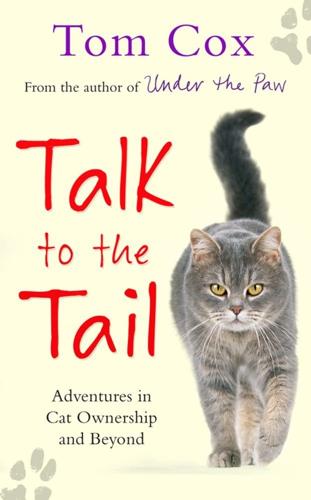
Talk to the Tail: Adventures in Cat Ownership and Beyond
by
Tom Cox
Published 1 Jan 2011
Dive across kitchen, just in time to remove face of Intellectually Challenged Cat Resembling TV Food Enthusiast Hugh Fearnley-Whittingstall from pilled dish of meaty slop. 7. While looking the other way and pretending to be occupied, quickly swoop down and pick up Intellectually Challenged Fluffy Cat Resembling Rock Musician Pete Townshend. Pick up pilled dish of meaty slop, and place cat and slop in adjacent room. 8. Remove face of Intellectually Challenged Cat Resembling TV Food Enthusiast Hugh Fearnley-Whittingstall from bottom of Intellectually Challenged Fluffy Cat Resembling Rock Musician Pete Townshend, and close door, firmly. 9.
…
Open cat food drawer, and keep Intellectually Challenged Fluffy Cat Resembling Rock Musician Pete Townshend’s interest by rustling sachet of meaty slop. 21. Take Tesco Finest Honey Roast Ham to pills. Realise ‘pills’ is now in fact ‘pill’. 22. Pick up Intellectually Challenged Cat Resembling TV Food Enthusiast Hugh Fearnley-Whittingstall and notice telltale pink smear around mouth of Intellectually Challenged Cat Resembling TV Food Enthusiast Hugh Fearnley-Whittingstall. 23. Wash hands, thoroughly. 24. Secrete remaining pill inside sheet of Tesco Finest Honey Roast Ham, creating pill sandwich. Step boldly towards Intellectually Challenged Fluffy Cat Resembling Rock Musician Pete Townshend and sweep Intellectually Challenged Fluffy Cat Resembling Rock Musician Pete Townshend off floor, then feed pill sandwich to Intellectually Challenged Fluffy Cat Resembling Rock Musician Pete Townshend. 25.
…
The Panic Mouse was supposed to make cats thinner, but if I wasn’t mistaken, Winter Pablo looked even larger than usual. Lying upside down, he was a veritable puddle of cat, spilling across the floor. For all his intermittent bulk, Pablo had always had a pointy sort of face, compared by many to that of the celebrity chef and smallholder Hugh Fearnley-Whittingstall, but now his jowls looked hideously stretched, his expression blank and moonlike. As he spotted me at the periphery of his vision, I saw none of the usual eagerness or nerves in his countenance, just something dopey and dazed. There’s a familiar moment when you taste some crisps you’ve picked out of a bowl at a party that you thought were one flavour, but are actually another flavour, and momentarily baulk at them.
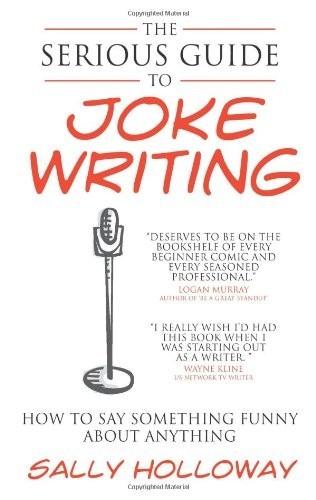
The Serious Guide to Joke Writing: How to Say Something Funny About Anything
by
Sally Holloway
Published 2 Nov 2010
I’m giving my class 20 minutes because I have put them into groups of four, so it’s easier for them. Saudi Arabian Minister Visits Britain Set up: The Queen rolled out the red carpet Punchline .................................................. Hugh Fearnley-Whittingstall (Who was in the studio when this joke was done.) Set up: One female journalist visited Hugh Fearnley-Whittingstall and felt sick when he presented her with an entire tongue, curled round fatly in the shape of a question mark Punchline .................................................. David Beckham Has Had Corn Rows Platted Into His Hair Set up: After his visit to the hairdresser he said that his head ‘hurt for a while’ Punchline ..................................................
…
Class Answers:xvii ...but he decided to buy a Persian rug instead. ...Prince Philip rolled out after. ...though next time she’s going for wood flooring. ...whilst round the back Prince Harry rolled up a spliff. Broadcast punchline: The Saudi Arabian minister said I could have got that for you half price. Hugh Fearnley-Whittingstall One female journalist visited Hugh Fearnley-Whittingstall and felt sick when he presented her with an ‘entire tongue, curled round fatly in the shape of a question mark’ Class Answers:xviii ...Not as sick as when he invited her to taste his semi-colon. ...Imagine where the exclamation mark came from. ...She had to be carted away in an ambulance when he showed her his penis. ...She was already full up with his Cumberland sausage. ...But he knew the answer would be a smack in the chops.
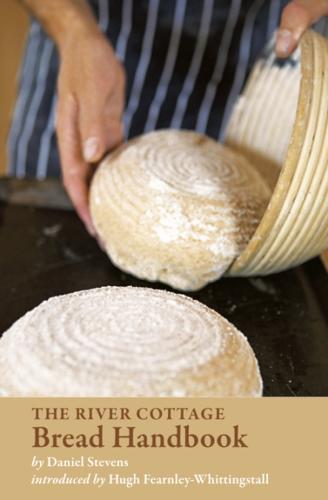
The River Cottage Bread Handbook
by
Daniel Stevens
Published 16 Feb 2009
Copyright © 1970 by the Chief Priest, Zen Center, San Francisco. Reprinted by arrangement with Shambhala Publications, Inc., Boston, www.shambhala.com. Library of Congress Cataloging-in-Publication Data is on file with the publisher. Stevens, Daniel (Dan) River Cottage bread handbook / Daniel Stevens; introduction by Hugh Fearnley-Whittingstall. — 1st U.S. ed. p. cm. Includes index. 1. Bread. 2. River Cottage (Television program) I. Title. TX769.S7985 2010 641.8'15—dc22 2010010618 eISBN: 978-1-607-74083-4 Project editor: Janet Illsley v3.1 Contents Introduction Why Bake Bread? Getting Started Bread Making Step-by-Step The Basic Bread Recipe Beyond the Basic Loaf Bread Made with Wild Yeast Bread Made without Yeast Buns, Biscuits & Batter Breads Using Leftover Bread Building a Clay Oven Useful Things Notes to the U.S.
…
I’m thrilled that in this handbook, Dan will get to share with you, and with many, his passion and knowledge. Whether you want to know how to bash out a simple white loaf, delight your family with buttery croissants, or fling together some Middle Eastern flat breads to wrap up the meat on your grill, you can be sure you’re in very safe, if rather floury, hands. Hugh Fearnley-Whittingstall, East Devon, February 2009 There is nothing in the world as satisfying to eat as home-baked, handmade bread. Of course, technically, the artisan baker down the road is much better at it, but no amount of skill and craftsmanship can replace the utter joy of eating and sharing the stuff you make yourself.
…
Erica Jarnes, thank you so much for your help, and for always looking pleased to see me. And Natalie Hunt, you have guided me through this brilliantly. I have felt properly looked after. I will miss my trips to the big city. Thank you so, so much. I hope we have made a book you are proud of. And everyone at River Cottage: Thank you to Rob Love and Hugh Fearnley-Whittingstall, for giving me this opportunity, for believing in me, and for sticking by me. And to Gill Meller, you have given me great help and massive support. I’ve run out of excuses now … I’d better get back in the kitchen. Cheers blood. Thank you to Nikki Duffy for starting me off so well, and for your time and energy and endless, endless patience.
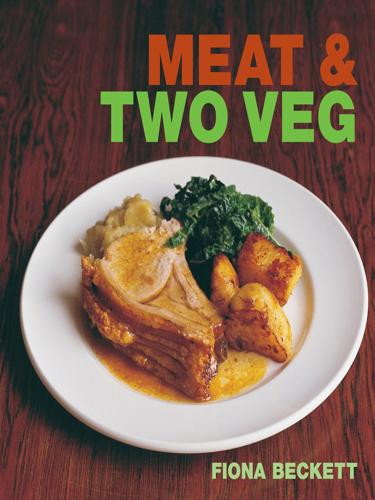
Meat & Two Veg
by
Fiona Beckett
A GRATIN DAUPHINOISE (here) OR BAKED TURNIPS WITH CREAM AND PARMESAN (here) WOULD BOTH BE GREAT WITH THIS. COOK THEM BEFORE YOU COOK THE LAMB AND SET THEM ASIDE IN A WARM PLACE. STUFFED LOIN OF LAMB WITH APRICOT, MINT AND PINENUTS It’s very easy to run up a stuffing that helps give a joint a dash of dinner-party glamour. This is an adaptation of a Hugh Fearnley-Whittingstall recipe, adding mint which I always think is irresistible with lamb. You’ll need to order this cut from your butcher. Get them to give you the bones; they will enrich the pan juices. SERVES 4 A 900g–1000g boned loin of lamb 1 tbsp olive oil 150ml dry white wine Butter paste (made from 1 tsp each flour and soft butter – see p58) Salt and freshly ground black pepper String for tying the meat FOR THE STUFFING 20g butter 1 small onion, peeled and very finely chopped 1 stick of celery, trimmed and very finely sliced 4–5 dried, ready-to-eat apricots, cut into small pieces 30g finely chopped pinenuts 40g fresh breadcrumbs from a traditional white or wholemeal loaf 2 tbsp finely chopped fresh mint Salt and pepper First make the stuffing.
…
I’m also a big fan of the Ginger Pig which trades in Borough Market and Moxon Street, off Marylebone High Street in London (020 7935 7788). GOOD ONLINE AND MAIL ORDER SUPPLIERS BROWN COW ORGANICS WWW.BROWNCOWORGANICS.CO.UK Much-awarded Somerset-based organic producer – a favourite of Hugh Fearnley-Whittingstall’s. DONALD RUSSELL WWW.DONALDRUSSELL.COM Well-established internet business, built on Scottish beef but now offering many other products. Particularly high standard of butchery. HERITAGE PRIME WWW.HERITAGEPRIME.CO.UK Not just organic but biodynamic. Great pork. HIGHER HACKNELL FARM WWW.HIGHERHACKNELL.CO.UK Another top West country organic meat producer.
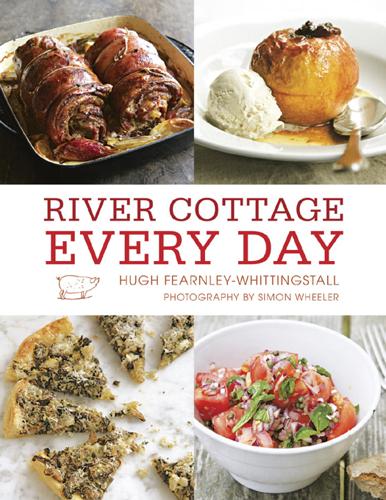
River Cottage Every Day
by
Hugh Fearnley-Whittingstall
Published 2 Jan 2009
Text copyright © 2009 by Hugh Fearnley-Whittingstall Photography copyright © 2009 by Simon Wheeler Additional photography copyright © 2009 by Marie Derôme (MD.1, MD.2, MD.3) Illustrations copyright © 2009 by Mariko Jesse All rights reserved. Published in the United States by Ten Speed Press, an imprint of the Crown Publishing Group, a division of Random House, Inc., New York. www.crownpublishing.com www.tenspeed.com Ten Speed Press and the Ten Speed Press colophon are registered trademarks of Random House, Inc. Originally published in slightly different form in Great Britain by Bloomsbury Publishing Plc, London, in 2009 Library of Congress Cataloging-in-Publication Data Fearnley-Whittingstall, Hugh.
…
Originally published in slightly different form in Great Britain by Bloomsbury Publishing Plc, London, in 2009 Library of Congress Cataloging-in-Publication Data Fearnley-Whittingstall, Hugh. River Cottage every day / Hugh Fearnley-Whittingstall; photography by Simon Wheeler. p. cm. Includes index. Summary: “A collection of more than 180 appealing everyday recipes from the bestselling author of the River Cottage series”—Provided by publisher. 1. Cooking (Natural foods) 2. Cooking, English. 3. River Cottage (Television program) I. Title. TX741.F426 2011 641.5’636—dc22 2010046949 eISBN: 978-1-60774-099-5 Project editor: Janet Illsley Copy editor: Jane Middleton Cover design: Chloe Rawlins Photography: Simon Wheeler Illustrations: Mariko Jesse (www.marikojesse.com) First U.S.
…
To Andrew Palmer and Zam Baring, Stephen Leigh and Jacky Sloane, and the team at Keo Films, thank you all for your hard work, support, and patience. And thank you, Rob Love, for your passion and commitment to all things River Cottage. And finally, thanks to Antony Topping, the best agent I (or anyone else) could possibly have. about the author Hugh Fearnley-Whittingstall is an award-winning writer, broadcaster, and food campaigner with an uncompromising commitment to seasonal, ethically produced food. He has been presenting programs for Channel Four for more than fifteen years, and this is the sixth River Cottage book he has written. His previous work includes The River Cottage Cookbook, for which he won the Glenfiddich Trophy; The River Cottage Meat Book and The River Cottage Fish Book, both of which won the André Simon Award; and The River Cottage Family Cookbook, which was the Guild of Food Writers Cookery Book of the Year.

River Cottage Veg: 200 Inspired Vegetable Recipes
by
Hugh Fearnley-Whittingstall
Published 31 Aug 2011
Copyright © 2011 by Hugh Fearnley-Whittingstall Photographs copyright © 2011 by Simon Wheeler Illustrations copyright © 2011 by Mariko Jesse All rights reserved. Published in the United States by Ten Speed Press, an imprint of the Crown Publishing Group, a division of Random House, Inc., New York. www.crownpublishing.com www.tenspeed.com Ten Speed Press and the Ten Speed Press colophon are registered trademarks of Random House, Inc. Originally published in slightly different form in hardcover in Great Britain as River Cottage Veg Everyday by Bloomsbury Publishing Plc, London, in 2011 First Ten Speed Press printing, 2013 Library of Congress Cataloging-in-Publication Data is on file with the publisher.
…
But over a third of them are (those marked (V)), and another third easily could be if suitable substitutes for butter and milk were used. If you’re a vegan, you’ll know what to do. I can certainly appreciate that if you’ve used my books, you may be feeling a bit baffled to be holding in your hand a near-as-damn-it vegetarian cookbook written by that notorious carnivore Hugh Fearnley-Whittingstall. But if you know my work a little more intimately, if you’ve probed and dabbled beyond the recipes and into the more discursive text, this should come as no great surprise – I’ve visited this territory before. Only now I’m at the vegetable end of the meat argument, and it’s a very refreshing place to be.
…
Try a sprinkle of seeds or dukka as well … • Dressed green lentils (V) • Spiced spinach and potatoes (V) • Broiled eggplants with chile and honey • Honey-roasted cherry tomatoes • Roasted squash (V) • Roasted potatoes and eggplants (V) • Roasted cauliflower with lemon and paprika (V) • Roasted parsnip “chips” (V) • Roasted new potatoes with two mojo sauces (V) • Roasted roots with apples and rosemary (V) • Roasted squash and shallots with merguez chickpeas (V) And, of course … • DIY pot noodles About the Author Hugh Fearnley-Whittingstall is an award-winning British writer, broadcaster, and food campaigner with an uncompromising commitment to seasonal, ethically produced food. He has been presenting programs for Channel Four in the UK for over fifteen years, and this is the seventh River Cottage book he has written. His previous work includes The River Cottage Cookbook, for which he won the Glenfiddich Trophy and the André Simon Award; The River Cottage Meat Book, which won the André Simon Award and the 2008 James Beard Cookbook of the Year Award; The River Cottage Fish Book, which also won the André Simon Award; The River Cottage Family Cookbook, which was the Guild of Food Writers Cookery Book of the Year; and River Cottage Every Day.
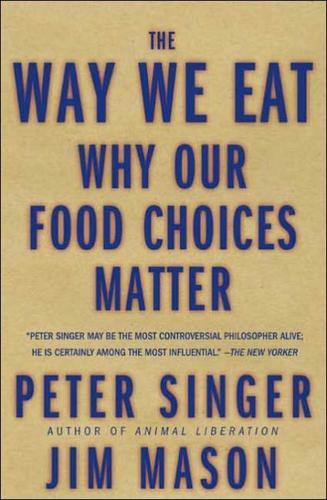
The Way We Eat: Why Our Food Choices Matter
by
Peter Singer
and
Jim Mason
Published 1 May 2006
We have seen how it inflicts prolonged suffering on sows who spend most of their lives in crates that are too narrow for them to turn around in; on caged hens; on chickens kept in unnaturally large flocks, bred to grow too fast, and transported and killed in appalling conditions; on dairy cows who are regularly made pregnant and separated from their calves; and on beef cattle kept in bare dirt feedlots. Though we like and respect Jake and Lee and take into account the time and economic pressures on families with children, we think that buying factory-farm products is not the right thing to do. You don't have to be a vegetarian to reach this conclusion. Hugh Fearnley-Whittingstall is the author of The River Cottage Meat Booka large, glossy book devoted to the cooking and eating of meat. Yet he writes: "The vast majority of our food animals are now raised under methods that are systematically abusive. For them, discomfort is the norm, pain is routine, growth is abnormal, and diet is unnatural.
…
Spending the same amount of money and buying fewer animal products would therefore be a good thing, especially if those animal products came from animals free to walk around outside, which would make the meat less fatty, and if the reduced consumption in animal products were offset by increased consumption of fruit and vegetables. That is the recommendation of Hugh Fearnley-Whittingstall, and few people are more devoted to food than he is. For perhaps a billion of the world's poorest people, hunger and malnutrition are still a problem. But factory farming isn't going to solve that problem, for in developing countries the industry caters to the growing urban middle class, not the poor, who cannot afford to buy its products.
…
Department of Agriculture, Wildlife Services, Table lOT "Number of Animals Killed and Methods Used by the WS Program, FY2004" www.aphis.usda.gov/ws/tables/04tables.htmi. 24 "It's better to green your diet than your car," New Scientist, 17, December 2005, p. 19, www.newscientist.com/channei/earth/mgl882S304.800. 25 The Editors, "Meat: Now, it's not personal," World Watch Magazine, July/August 2004, www.worldwatch.org/pubs/mag/2004/174/. CHAPTER 17 1 Hugh Fearnley-Whittingstall, The River Cottage Meat Book, Hodder and Stoughton, London, 2004, p. 24. 2 Michael Pollan, "An Animal's Place," The New York Times Sunday Magazine, November 10, 2002; see also Michael Pollan, The Omnivore's Dilemma: A Natural History of Four Meals, Penguin, New York, 2006. 3 Sholto Byrnes, "Roger Scruton: The Patron Saint of Lost Causes," The Independent, July 3, 2005, http: //enjoyment. i ndependent.co.uk /books/features/article296509.ece 4 Roger Scruton, Animal Rights and Wrongs, 3rd ed., Claridge Press, 2003. 5 Matthew Scully, "Fear Factories: The Case for Compassionate Conservatism-for Animals," The American Conservative, May 23, 2005; George F.
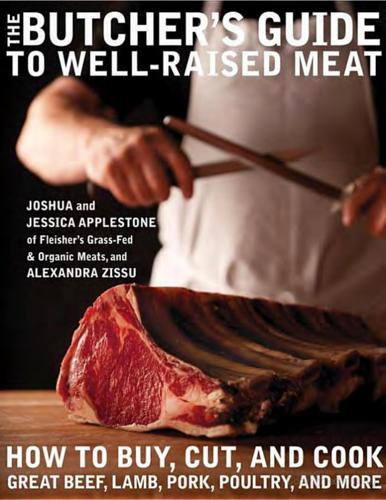
The Butcher's Guide to Well-Raised Meat: How to Buy, Cut, and Cook Great Beef, Lamb, Pork, Poultry, and More
by
Joshua Applestone
,
Jessica Applestone
and
Alexandra Zissu
Published 6 Jun 2011
In most parts of Europe and Asia folks still eat this way, and it’s an accepted fact that no part of the animal should go to waste. You can (and should) eat every part of the pig except the squeal. The cookbooks that we love the most and nd most inspirational—including The River Cottage Meat Book, by Hugh Fearnley-Whittingstall; The Whole Beast: Nose to Tail Eating, by Fergus Henderson; and Pork and Sons, by Stéphane Reynaud—echo this sentiment. O al is not only good food; eating it demonstrates a certain respect for the animal. So, tap into your heritage (or try someone else’s on for size) and get yourself a taste of chopped liver with schmaltz and gribbnitz 58 (chicken fat and skin), haggis, steak and kidney pie, liverwurst, chitterlings (pig intestines), scrapple, southern fried giblets, curried oxtail, and tendon soup.
…
Join the fun at meatingplace.com. 324 BOOKS Animals in Translation: Using the Mysteries of Autism to Decode Animal Behavior by Temple Grandin The CAFO Reader: The Tragedy of Industrial Animal Factories by Daniel Imhoff Charcuterie: The Craft of Salting, Smoking, and Curing by Michael Ruhlman and Brian Polcyn Cleaving: A Story of Marriage, Meat, and Obsession by Julie Powell The Conscious Kitchen: The New Way to Buy and Cook Food—To Protect the Earth, Improve Your Health, and Eat Deliciously by Alexandra Zissu Fast Food Nation: The Dark Side of the All-American Meal by Eric Schlosser The Flavor Bible: The Essential Guide to Culinary Creativity, Based on the Wisdom of America’s Most Imaginative Chefs by Karen Page and Andrew Dornenburg Heat: An Amateur’s Adventures as Kitchen Slave, Line Cook, PastaMaker, and Apprentice to a Dante-Quoting Butcher in Tuscany by Bill Buford The Jungle by Upton Sinclair Kitchen Pro Series: Guide to Meat Identi cation, Fabrication, and Utilization and Guide to Poultry Identi cation, Fabrication, and Utilization by Thomas Schneller and the Culinary Institute of America Meat: A Kitchen Education by James Peterson The Meat Buyer’s Guide and The Poultry Buyer’s Guide by the North American Meat Processors Association The Niman Ranch Cookbook: From Farm to Table with America’s 325 Finest Meat by Bill Niman and Janet Fletcher The Omnivore’s Dilemma: A Natural History of Four Meals by Michael Pollan Pig Perfect: Encounters with Remarkable Swine and Some Great Ways to Cook Them by Peter Kaminsky Pork and Sons by Stéphane Reynaud Primal Cuts: Cooking with America’s Best Butchers by Marissa Guggiana Raising Steaks: The Life and Times of American Beef by Betty Fussell Righteous Porkchop: Finding a Life and Good Food Beyond Factory Farms by Nicolette Hahn Niman The River Cottage Meat Book by Hugh Fearnley-Whittingstall Salad Bar Beef and Everything I Want to Do Is Illegal by Joel Salatin Seven Fires: Grilling the Argentine Way by Francis Mallmann and Peter Kaminsky The Whole Beast: Nose to Tail Eating by Fergus Henderson SOURCES • The herbs and spices for our rubs, sausages, and marinades come from Mountain Rose Herbs: mountainroseherbs.com. • For all of your butcher paper, twine, cutting, and sausagemaking needs, head to butcher-packer.com or sausagemaker.com. • For our favorite stovetop-to-oven steel pans, check out www.debuyer.com. • For our preferred enamel-coated cast-iron pots, visit lecreuset.com. • For more specifics on roasting whole pigs, including 326 charcoal, wood, building fires, tips, and timing as you plan your roast, go to the sections on roasting a whole pig at firepit-and-grilling-guru.com and askthemeatman.com. • The all important metal aprons can be found at Saf-T-Guard, saftguard.com. 327 328 ACKNOWLEDGMENTS Josh and Jessica Applestone would like to thank the “old men” of the business who taught us everything we know: Tom, Bob, Kent, Bill, Jan, Hans, and of course, Ted.
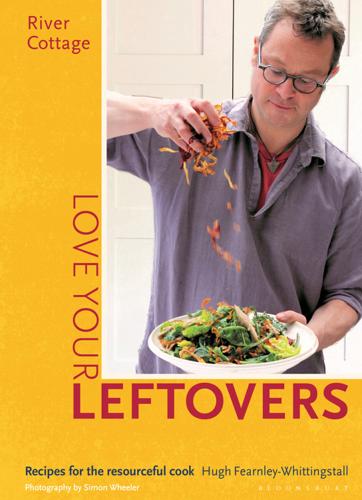
River Cottage Love Your Leftovers
by
Hugh Fearnley-Whittingstall
Published 2 Dec 2015
Bloomsbury Publishing An imprint of Bloomsbury Publishing Plc 50 Bedford Square 1385 Broadway London New York WC1B 3DP NY 10018 UK USA www.bloomsbury.com Bloomsbury is a registered trademark of Bloomsbury Publishing Plc This electronic edition published in 2015 by Bloomsbury Publishing Plc First published in Great Britain 2015 Text ©Hugh Fearnley-Whittingstall, 2015 Photography ©Simon Wheeler, 2015 Photograph here ©Marie Derôme, 2015 Illustrations ©Tim Hopgood, 2015 Hugh Fearnley-Whittingstall has asserted his right under the Copyright, Designs and Patents Act, 1988, to be identified as Author of this work. All rights reserved You may not copy, distribute, transmit, reproduce or otherwise make available this publication (or any part of it) in any form, or by any means (including without limitation electronic, digital, optical, mechanical, photocopying, printing, recording or otherwise), without the prior written permission of the publisher.
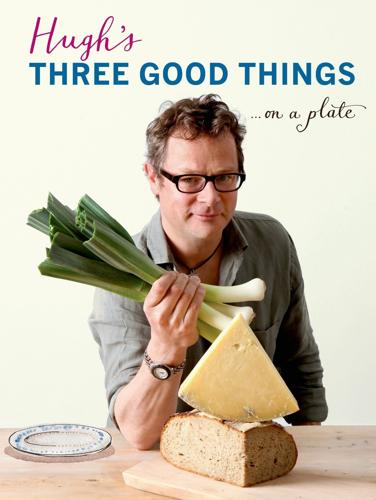
Hugh's Three Good Things
by
Hugh Fearnley-Whittingstall
Published 13 Apr 2015
For Antony, Richard and Simon, who are definitely Three Good Things HUGH FEARNLEY-WHITTINGSTALL is a writer, broadcaster and campaigner. His series for Channel 4 have earned him a huge popular following, while his books have collected multiple awards including the Glenfiddich Trophy (twice), the André Simon Food Book of the Year (three times), the Michael Smith Award (twice) and, in the US, the James Beard Cookbook of the Year. Hugh lives in Devon with his family. First published in Great Britain 2012 Text copyright © 2012 by Hugh Fearnley-Whittingstall Photography © 2012 by Simon Wheeler Photographs of ‘Egg, purple sprouting, garam masala’, ‘Mackerel, oatmeal, rhubarb’ and Fruit introduction © 2012 by Marie Derôme Illustrations © 2012 by Mariko Jesse The moral right of the author has been asserted.
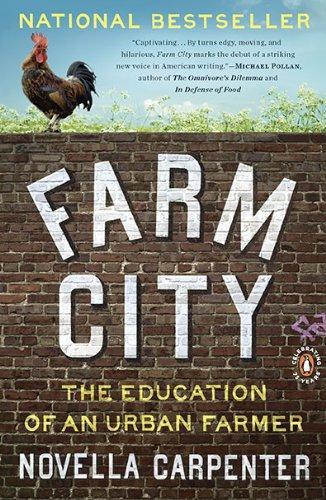
Farm City: The Education of an Urban Farmer
by
Novella Carpenter
Published 25 May 2010
Following the recipe in Charcuterie, I re-created a gamey but delicious duck prosciutto I had had in France. To make it, I simply rubbed the breasts with salt, added a coating of pepper, and stowed them in the fridge for a few weeks. The geese I put in the freezer to make goose sausages at a later date. Chef Hugh Fearnley-Whittingstall, the author of The River Cottage Meat Book, would be my guiding light. He inspired me, going on in his British way about duck confit: “Having a jar just sitting in the larder, bursting with savory potential, makes me salivate every time I see it.” A confit is meat preserved by storing it in a thick layer of rendered fat.
…
From behind a jar of sauerkraut and a half-empty container of stewed plums I pulled out the intestine-filled bag. It visibly quivered. I remembered my indignation, my disgust, at Sheila’s waste. Suddenly, it seemed quite reasonable. Ugh, just throw that shit away! But no, between Fergus Henderson and Hugh Fearnley-Whittingstall, I could find recipes for this bag of offal. Which smelled awful, by the way. I sloshed the bag onto the counter and untied the handles. Inside, cradled by white plastic, lay a liver the size of a placenta. It was a strange red color, almost blue. Next to it sat, rather perkily, a greenish thing that I had to assume was the stomach.
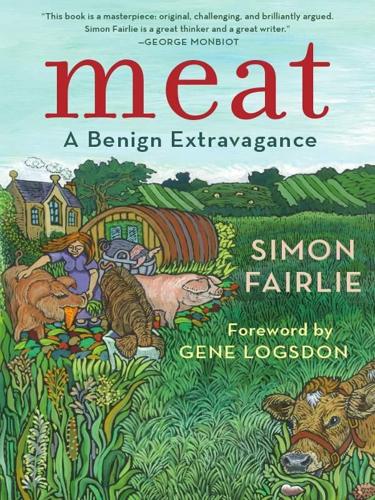
Meat: A Benign Extravagance
by
Simon Fairlie
Published 14 Jun 2010
‘These pomo eaters have decided to walk on bare feet because they have decided to eat their own shoes,’ the provost of the Zaria College of Leather Technology was reported as saying.22 Which parts of a carcase are edible, or not, depends on social factors: how rich people are, what alternatives are available, and nowadays, what advertisers, health geeks and celebrity chefs happen to be propagating. In 1986 British people ate 1.1 kilos of offal per year out of 54 kilos of meat. In 2008 they consumed even more meat – 58 kilos – but a pathetic 250 grams of offal. Probably most offal eaters are now over the age of 60.23 However chefs such as Hugh Fearnley-Whittingstall and Jamie Oliver are now propagating the virtues of ‘the fifth quarter’, so we may see the decline in offal consumption reversed. In the days when there were still horse-drawn rag and bone men providing a door-to-door recycling service, my mother used to boil up beef or chicken bones and scraps for stock which became the foundation for a quality of soup that many people under the age of 40 have never tasted.
…
Over the last few years there has also been a discernible rise in the number of backyard and small-scale pigkeepers. There are no figures for this, and if there were they would be insignificant; but the shift in attitudes towards pigs, influenced by the campaigns of celebrity chefs like Hugh Fearnley-Whittingstall and the TV pigman Jimmy Doherty, is gathering pace. No cottage pig-keeper has any problem finding buyers for non-industrial pork or home cured bacon. Many of these small-scale producers will be giving whatever food waste they have to their pigs, because that is what pigs are for. Often this is a minimal quantity, compared to a pig’s voracious appetite: the amount of food wasted by a normal family is nowhere near enough to fatten a hog.

What's Mine Is Yours: How Collaborative Consumption Is Changing the Way We Live
by
Rachel Botsman
and
Roo Rogers
Published 2 Jan 2010
Statistics taken from Morgan Stanley, “The Mobile Internet Report” (December 15, 2009). Key excerpts can be found at www.emarketer.com/Reports/All/Emarketer_2000639.aspx 16. Mark Diacono, “Mr. Green, Meet Mrs. Brown: Landshare Explained,” Guardian (June 2009), www.guardian.co.uk/lifeandstyle/gardeningblog/2009/jun/05/landshare-hugh-fearnley-whittingstall. 17. “Commons Sense,” Economist (July 31, 2008), www.cs.ucl.ac.uk/staff/d.quercia/others/commons.pdf. 18. “The Tragedy of the Commons” is an influential article written by Garrett Hardin. First published in Science 162, no. 3859 (December 13, 1968): 1243–1248. 19. The idea of traffic congestion and “The Tragedy of the Commons” is documented in Garrett Hardin, Living Within Means (Oxford University Press, 1993).
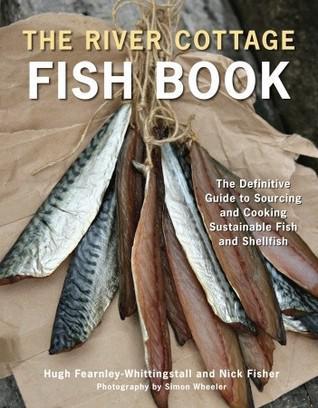
The River Cottage Fish Book: The Definitive Guide to Sourcing and Cooking Sustainable Fish and Shellfish
by
Hugh Fearnley-Whittingstall
Published 19 Nov 2007
Copyright © 2007 by Hugh Fearnley-Whittingstall and Nick Fisher Photographs copyright © 2007 by Simon Wheeler Additional photography copyright © 2007 by Paul Quagliana, Marie Derôme, and other contributors (see Picture Credits) All rights reserved. Published in the United States by Ten Speed Press, an imprint of the Crown Publishing Group, a division of Random House, Inc., New York. www.crownpublishing.com www.tenspeed.com Originally published in slightly different form in Great Britain by Bloomsbury Publishing Plc, London, in 2007 First Ten Speed Press printing, 2012 Ten Speed Press and the Ten Speed Press colophon are registered trademarks of Random House, Inc.
…
www.crownpublishing.com www.tenspeed.com Originally published in slightly different form in Great Britain by Bloomsbury Publishing Plc, London, in 2007 First Ten Speed Press printing, 2012 Ten Speed Press and the Ten Speed Press colophon are registered trademarks of Random House, Inc. Library of Congress Cataloging-in-Publication Data Fearnley-Whittingstall, Hugh. The River Cottage fish book : the definitive guide to sourcing and cooking sustainable fish and shellfish / Hugh Fearnley-Whittingstall and Nick Fisher ; photography by Simon Wheeler ; additional photography by Paul Quagliana and Marie Derôme Fisher. — 1st U.S. ed. p. cm. Includes index. 1. Cooking (Fish) 2. Cooking (Shellfish) 3. Cooking (Seafood) 4. Fishes—Great Britain. I. Fisher, Nick, 1953- II. Title. TX747.F38 2012 641.6’92—dc23 2011038382 eISBN: 978-1-60774-063-6 Project editor: Janet Illsley Cover design: Chloe Rawlins Photography: Simon Wheeler v3.1 For Oscar and his godfather, Charlie, my two other favorite fishing companions.

Living in a Material World: The Commodity Connection
by
Kevin Morrison
Published 15 Jul 2008
This type of poultry farming is a world away from the days of my childhood in the 1970s, when I remember the chickens and hens running around my uncle’s farmyard; ‘as free as a bird’, you could say. The saying is far from the truth for the battery-farmed chicken of today. Awareness of these farming methods has heightened among conscientious consumers and many are now demanding free-range farming techniques. Television stars such as Pamela Anderson and UK TV chefs Hugh Fearnley-Whittingstall and Jamie Oliver have also raised awareness of the issue of factory farming through high profile campaigns. Tyson, the world’s largest meat producer, proudly boasts that improved animal diet, selective breeding, production technologies, equipment development and better management practices have enabled the industry to speed up meat production (Tyson Foods Inc., 2005–6).
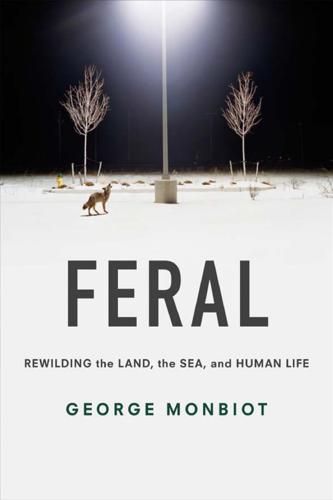
Feral: Rewilding the Land, the Sea, and Human Life
by
George Monbiot
Published 13 May 2013
—The Guardian “Part personal journal, part rigorous (and riveting) natural history, but above all unbridled vision for a less cowed, more self-willed planet, this is a book that will change the way you think about the natural world, and your place in it. Big, bold and beautifully written, his vision of a rewilded world is, well, truly captivating.” —Hugh Fearnley-Whittingstall, celebrity chef and author of The River Cottage Cookbook “A Book of Revelations for our times. It warns us in no uncertain terms that if we don’t change our ways in the hell of a hurry, we’ll have done two other things: 1) Committed the ultimate crime of biocide; and 2) Hanged ourselves in the process thereof.
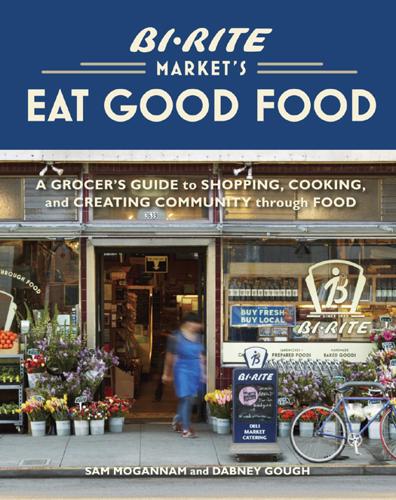
Bi-Rite Market's Eat Good Food: A Grocer's Guide to Shopping, Cooking & Creating Community Through Food
by
Sam Mogannam
and
Dabney Gough
Published 17 Oct 2011
GENERAL GOOD READING Publications, Blogs, and Radio Civil Eats: civileats.com Diner Journal: dinerjournal.com Edible Communities: ediblecommunities.com Free Range Studios: freerangestudios.com Grist: grist.org Livable Future Blog: livablefutureblog.com Public Radio Kitchen: publicradiokitchen.org The Story of Stuff: thestoryofstuff.com The True Cost of Food Video: sierraclub.org/truecostoffood/movie.asp Organizations ALBA, The Agriculture and Land-Based Training Association: albafarmers.org Craft Brew: craftbrew.org Eat Local Challenge: eatlocalchallenge.com Food Alliance: foodalliance.org Organic Consumers: organicconsumers.org Slow Food USA: slowfoodusa.org Southern Foodways Alliance: southernfoodways.com Stone Barns Center: stonebarnscenter.org SPECIFIC TOPICS The Food System Bringing It to the Table: On Farming and Food by Wendell Berry Cheap by Ellen Ruppel Shell Diet for a Hot Planet: The Climate Crisis at the End of Your Fork and What You Can Do about It by Anna Lappé and Bill McKibben Ethics of What We Eat: Why Our Food Choices Matter by Peter Singer and Jim Mason Fast Food Nation by Eric Schlosser Food Rules by Michael Pollan Grub: Ideas for an Urban Organic Kitchen by Anna Lappé and Bryant Terry The Omnivore’s Dilemma by Michael Pollan The Rough Guide to Food, UK edition The Unprejudiced Palate by Angelo Pellegrini Shopping, Ingredients, and Cooking GENERAL/MULTIPLE TOPICS Eating Between the Lines by Kimberly Lord Stewart Food Lover’s Companion by Sharon Taylor Herbst Food Matters by Mark Bittman Grub by Anna Lappé and Bryant Terry How to Cook Everything by Mark Bittman On Food and Cooking by Harold McGee What to Eat by Marion Nestle Zingerman’s Guide to Good Eating by Ari Weinzweig PANTRY California Olive Oil Council: cooc.com The New American Olive Oil by Fran Gage PRODUCE The Complete Vegetable Book by Clare Connery Environmental Working Group, publisher of the “Dirty Dozen” list of most heavily sprayed produce crops: ewg.org, including the Dirty Dozen list and app: foodnews.org/walletguide.php Field Guide to Produce by Aliza Green The Greenhorns, an organization for and by young farmers: greenhorns.net Melissa’s Great Book of Produce by Cathy Thomas BUTCHER AND SEAFOOD American Grass Fed: www.americangrassfed.org Animal Welfare Approved: animalwelfareapproved.org Blue Ocean Institute: blueocean.org Certified Humane: certifiedhumane.org Environmental Defense Fund, information on contaminants in fish: edf.org Environmental Defense Fund’s Seafood Selector: oceansalive.org Ethics of What We Eat: Why Our Food Choices Matter by Peter Singer and Jim Mason Field Guide to Meat by Aliza Green Fish Forever by Paul Johnson FishWise (retail labeling program): sustainablefishery.org Good Meat by Deborah Krasner Marine Stewardship Council: msc.org Monterey Bay Aquarium Seafood Guide: seafoodwatch.org New England Aquarium: neaq.org Primal Cuts: Cooking with America’s Best Butchers by Marissa Guggiana Righteous Porkchop by Nicolette Hahn Niman The River Cottage Meat Book by Hugh Fearnley-Whittingstall DAIRY AND CHEESE American Farmstead Cheese by Paul Kindstedt Atlas of American Artisan Cheese by Jeffrey Roberts The Cheese Companion by Judy Ridgeway Cheese Lover’s Companion by Sharon Tyler Herbst and Ron Herbst The Cheese Primer by Steve Jenkins The New American Cheese by Laura Werlin The Untold Story of Milk by Ron Schmid WINE The Oxford Companion to Wine by Jancis Robinson Wine Lover’s Companion by Ron Herbst The Natural Process Alliance, an industry organization that sets standards for natural winemaking: naturalprocessalliance.us WHERE TO BUY Helpful Resources to Find Local, Sustainable Food Localharvest, an online resource for finding farms, ranches, farmers’ markets, CSAs, and artisan food producers near you: localharvest.org Eat Well Guide, another resource that also includes restaurants, wholesale vendors, stores, and personal chefs: eatwellguide.org Eatwild, a nationwide directory of farms that raise their animals on pasture: eatwild.com/products The Green Guide, which provides information on making green choices in what you eat (and the rest of your life, too): thegreenguide.com Sustainable Table rBGH-free list, provides information on rBGH-free dairy brands sold in your area: sustainabletable.org/shop/dairymap Some Favorite Mail-Order Sources Cowgirl Creamery, for their own as well as other artisanal cheeses: cowgirlcreamery.com Dean & Deluca, especially good for high-quality olive oils, vinegars, and spices: deandeluca.com Di Bruno Brothers, purveyors of cured meats, cheeses, oils, and other specialty items: dibruno.com Foodzie, an online resource for small-batch, artisanal food products: foodzie.com Formaticum, source for cheese paper: formaticum.com Heritage Foods USA, mail-order heritage meats, including turkeys and also a great source of information on heirloom ingredients: heritagefoodsusa.com Kalustyan’s, a New York institution known particularly for their spices; they also have a huge array of beans and grains, condiments, pickles, candies, snacks, and other specialty items from near and far: kalustyans.com Market Hall Foods, where I got my start in specialty food!

The Rough Guide to Devon & Cornwall
by
Robert Andrews
There’s plenty of choice on the menu, usually including Exmouth mussels (£8), mushroom stroganoff (£11), duck leg confit (£14) and a superb fish stew (£17). Sit upstairs for the view. Mon–Sat noon–2.30pm & 5pm–late, Sun noon–3pm & 6–8.30pm. River Cottage Canteen & Deli Royal William Yard, Stonehouse, PL1 3QQ 01752 252702, rivercottage.net. Celebrity chef Hugh Fearnley-Whittingstall’s industrial-looking café and restaurant in the old brewhouse of the ex-naval depot is focused on the organic, local and seasonal. With some tables outside, the place has a pleasant buzz, and the menu ranges from brunches and teas to fried polenta, baked mackerel and venison stew (all £11–15).
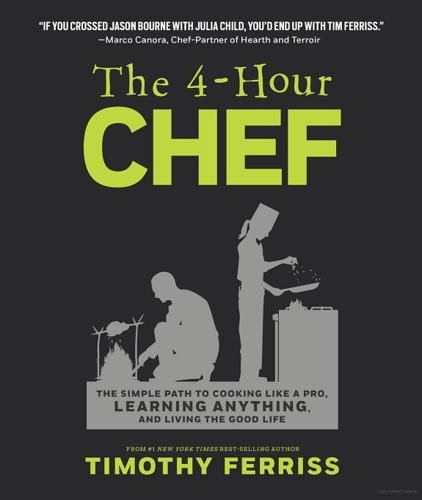
The 4-Hour Chef: The Simple Path to Cooking Like a Pro, Learning Anything, and Living the Good Life
by
Timothy Ferriss
Published 1 Jan 2012
MAGAZINES There are many wonderful food magazines, but here are three you might not see on local newsstands: Cook’s Illustrated—cooksillustrated.com The Art of Eating—artofeating.com Gastronomica—gastronomica.org TRAVEL COOKING KIT While traveling, I checked a Polder probe thermometer and timer, a 6" chef’s knife with a blade guard, and a small plastic cutting board, so I could conduct experiments in hotel rooms. BOOKS Becoming a Chef (Andrew Dornenburg, Karen Page) Mission Street Food (Anthony Myint, Karen Leibowitz) The Whole Beast: Nose to Tail Eating (Fergus Henderson) White Heat (Marco Pierre White) The River Cottage Meat Book (Hugh Fearnley-Whittingstall) La Technique (Jacques Pepin) The River Cafe Cookbook and variants (Rose Gray, Ruth Rogers) Culinary Artistry (Andrew Dornenburg, Karen Page) The Kitchen Diaries: A Year in the Kitchen with Nigel Slater (Nigel Slater) THE VON RESTORFF EFFECT The Von Restorff effect, also called the novel popout effect,‡ correlates unique items in a list to better recall.

Tools of Titans: The Tactics, Routines, and Habits of Billionaires, Icons, and World-Class Performers
by
Timothy Ferriss
Published 6 Dec 2016
If you’ve ever fantasized about saying “Fuck it,” quitting your job, and going back to the land, buy this as a present for yourself. If you’ve ever dreamed of getting out of the city and moving to Montana or God-knows-where rural Utopia, procuring your own food and so on, then this is your Scooby snack. It’s endearingly retro, like a warm quilt from Mom, and host/chef Hugh Fearnley-Whittingstall will make you want to grow tomatoes, even if you hate tomatoes. And catch eels, too. Don’t forget the eels. Into the Darkness * * * Sleep Master sleep mask and Mack’s Pillow Soft Silicone Putty (ear plugs): The Sleep Master sleep mask—great product, terrible name. I’ve tried dozens of sleep masks, and this is my favorite.
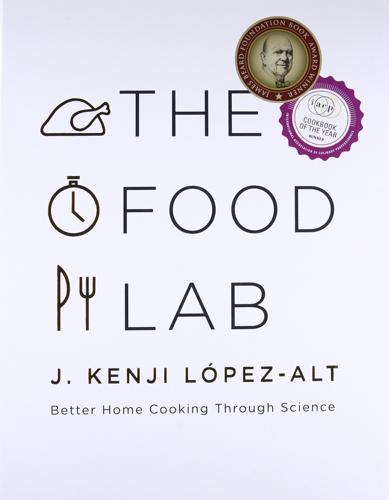
The Food Lab: Better Home Cooking Through Science
by
J. Kenji López-Alt
Published 20 Sep 2015
Any writer who tells you that their voice and style are all their own are lying to you. We’re all influenced by who we read. My writing is a stew of mannerisms, jokes, and styles that I’ve mashed together from all over the place. Jeffrey Steingarten and Michael Ruhlman taught me that gonzo journalism is alive and well in the food world. Hugh Fearnley Whittingstall and Anthony Bourdain reminded me that good food writing, like all good writing, has to be personal. Jacques Pepin’s mastery of technique and his ability to express not just how to do something but why you should care is breathtaking (his “Complete Techniques” makes for some riveting beach reading.